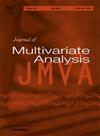多臂临床试验多变量纵向数据的非参数u统计检验方法
IF 1.4
3区 数学
Q2 STATISTICS & PROBABILITY
引用次数: 0
摘要
随机临床试验(RCTs)通常涉及多个纵向主要结局,以全面评估治疗效果。纵向秩和检验(LRST) Xu et al.(2025)是一种稳健的基于u统计的、非参数的、基于秩的方法,通过利用数据的时间结构而不依赖于分布假设,有效地控制了I型误差并增强了统计能力。然而,LRST仅限于双臂比较。为了解决在许多随机对照试验中需要与对照组进行多剂量比较的问题,我们将LRST扩展到多组设置。这种新型的多臂LRST为评估多臂治疗疗效和结果提供了一种灵活而强大的方法,具有在多臂试验中检测最有效剂量的强大能力。大量的仿真表明,与具有多重调整的双臂LRST相比,该方法保持了出色的I型误差控制,同时提供了更大的功率。Bapineuzumab (Bapi) 301试验的应用进一步验证了多臂LRST的实用性和稳健性,证实了其在复杂临床试验分析中的有效性。本文章由计算机程序翻译,如有差异,请以英文原文为准。
A non-parametric U-statistic testing approach for multi-arm clinical trials with multivariate longitudinal data
Randomized clinical trials (RCTs) often involve multiple longitudinal primary outcomes to comprehensively assess treatment efficacy. The Longitudinal Rank-Sum Test (LRST) Xu et al. (2025), a robust U-statistics-based, non-parametric, rank-based method, effectively controls Type I error and enhances statistical power by leveraging the temporal structure of the data without relying on distributional assumptions. However, the LRST is limited to two-arm comparisons. To address the need for comparing multiple doses against a control group in many RCTs, we extend the LRST to a multi-arm setting. This novel multi-arm LRST provides a flexible and powerful approach for evaluating treatment efficacy across multiple arms and outcomes, with a strong capability for detecting the most effective dose in multi-arm trials. Extensive simulations demonstrate that this method maintains excellent Type I error control while providing greater power compared to the two-arm LRST with multiplicity adjustments. Application to the Bapineuzumab (Bapi) 301 trial further validates the multi-arm LRST’s practical utility and robustness, confirming its efficacy in complex clinical trial analyses.
求助全文
通过发布文献求助,成功后即可免费获取论文全文。
去求助
来源期刊

Journal of Multivariate Analysis
数学-统计学与概率论
CiteScore
2.40
自引率
25.00%
发文量
108
审稿时长
74 days
期刊介绍:
Founded in 1971, the Journal of Multivariate Analysis (JMVA) is the central venue for the publication of new, relevant methodology and particularly innovative applications pertaining to the analysis and interpretation of multidimensional data.
The journal welcomes contributions to all aspects of multivariate data analysis and modeling, including cluster analysis, discriminant analysis, factor analysis, and multidimensional continuous or discrete distribution theory. Topics of current interest include, but are not limited to, inferential aspects of
Copula modeling
Functional data analysis
Graphical modeling
High-dimensional data analysis
Image analysis
Multivariate extreme-value theory
Sparse modeling
Spatial statistics.
 求助内容:
求助内容: 应助结果提醒方式:
应助结果提醒方式:


